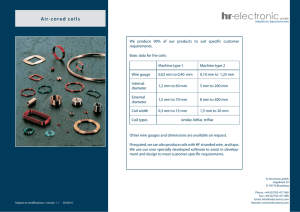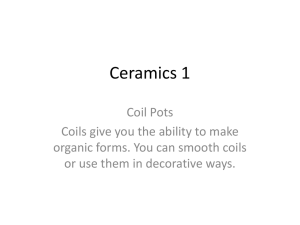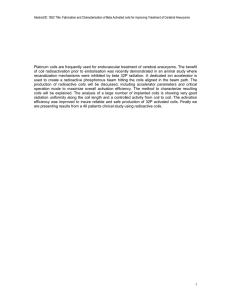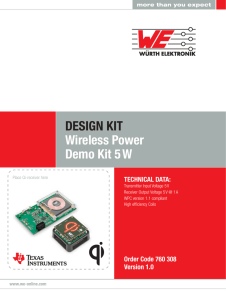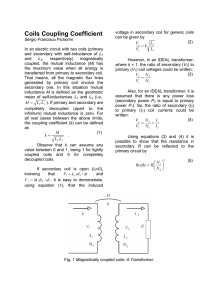23.82.00 Air Coils - University of Pennsylvania
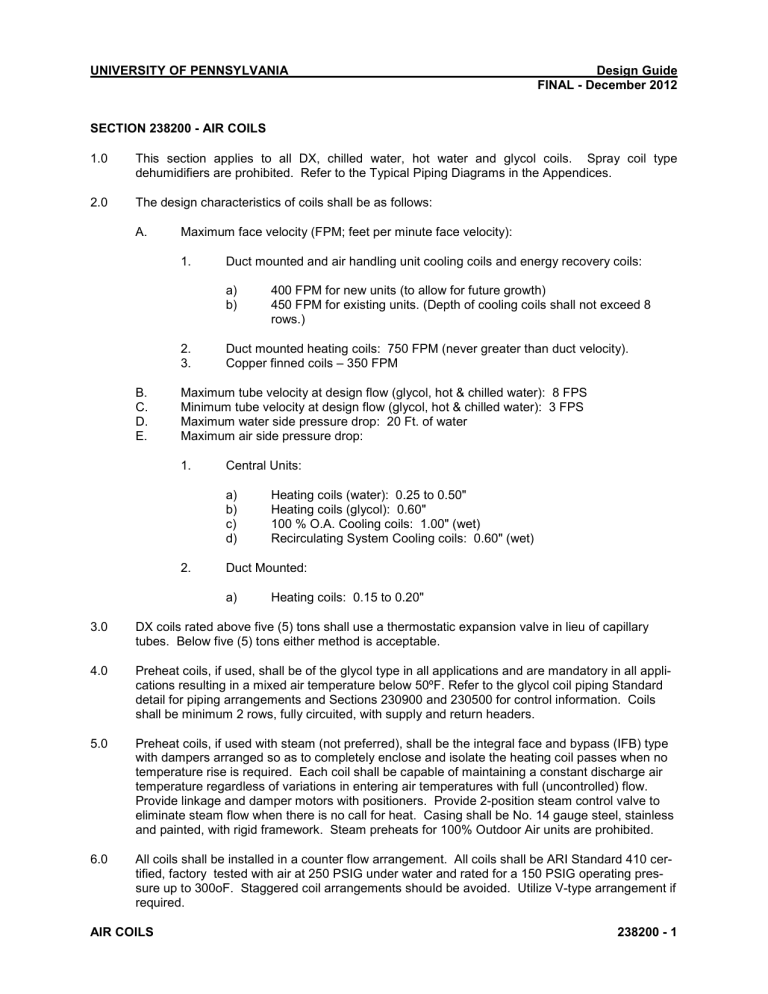
UNIVERSITY OF PENNSYLVANIA
SECTION 238200 AIR COILS
1.0
2.0
Design Guide
FINAL December 2012
This section applies to all DX, chilled water, hot water and glycol coils. Spray coil type dehumidifiers are prohibited. Refer to the Typical Piping Diagrams in the Appendices.
The design characteristics of coils shall be as follows:
A. Maximum face velocity (FPM; feet per minute face velocity):
B.
C.
D.
E.
1. Duct mounted and air handling unit cooling coils and energy recovery coils: a) b)
400 FPM for new units (to allow for future growth)
450 FPM for existing units. (Depth of cooling coils shall not exceed 8 rows.)
2.
3.
Duct mounted heating coils: 750 FPM (never greater than duct velocity).
Copper finned coils – 350 FPM
Maximum tube velocity at design flow (glycol, hot & chilled water): 8 FPS
Minimum tube velocity at design flow (glycol, hot & chilled water): 3 FPS
Maximum water side pressure drop: 20 Ft. of water
Maximum air side pressure drop:
1. Central Units:
2. a) b) c) d)
Heating coils (water): 0.25 to 0.50"
Heating coils (glycol): 0.60"
100 % O.A. Cooling coils: 1.00" (wet)
Recirculating System Cooling coils: 0.60" (wet)
Duct Mounted:
3.0
4.0
5.0 a) Heating coils: 0.15 to 0.20"
DX coils rated above five (5) tons shall use a thermostatic expansion valve in lieu of capillary tubes. Below five (5) tons either method is acceptable.
Preheat coils, if used, shall be of the glycol type in all applications and are mandatory in all appli: cations resulting in a mixed air temperature below 50ºF. Refer to the glycol coil piping Standard detail for piping arrangements and Sections 230900 and 230500 for control information. Coils shall be minimum 2 rows, fully circuited, with supply and return headers.
Preheat coils, if used with steam (not preferred), shall be the integral face and bypass (IFB) type with dampers arranged so as to completely enclose and isolate the heating coil passes when no temperature rise is required. Each coil shall be capable of maintaining a constant discharge air temperature regardless of variations in entering air temperatures with full (uncontrolled) flow.
Provide linkage and damper motors with positioners. Provide 2:position steam control valve to eliminate steam flow when there is no call for heat. Casing shall be No. 14 gauge steel, stainless and painted, with rigid framework. Steam preheats for 100% Outdoor Air units are prohibited.
6.0 All coils shall be installed in a counter flow arrangement. All coils shall be ARI Standard 410 cer: tified, factory tested with air at 250 PSIG under water and rated for a 150 PSIG operating pres: sure up to 300oF. Staggered coil arrangements should be avoided. Utilize V:type arrangement if required.
AIR COILS 238200 1
UNIVERSITY OF PENNSYLVANIA
7.0 Coils shall be constructed of the following materials:
Design Guide
FINAL December 2012
8.0
A.
B.
C.
D.
E.
F.
G.
Primary Surface : Tubes : minimum 5/8" OD (1/2" OD for refrigerant coils) by 0.035 inch wall thickness seamless copper with die formed return bends silver soldered to the tubes.
Tubes shall be expanded to form a mechanical bond with the secondary surface fins.
Depth of cooling coils shall not exceed 8 rows.
Secondary Surface : Fins : Die:formed aluminum fins minimum .010” thick designed to minimize carryover. Copper fins in environments corrosive to aluminum fins. Fin density shall not exceed 10 fins/inch maximum.
Headers : Seamless copper tubing silver soldered to tubes. Connections shall be of red brass with male pipe threads, silver soldered to the headers. Each header shall contain a
1/4" FPT vent and a 1/4" FP drain tapping. Connection to headers shall be arranged for counter:flow operation with supply connections on the bottom and return connections at the top. Provide all water and glycol coils with two (2) headers ("Contractor's Coil").
Headers shall be constructed for 250 psig operating pressure.
Casing : Structural strength of casing material shall be suitable for stacking of coils with end tube sheets to support tubes. All coils with finned lengths 60" or greater shall be provided with intermediate tube supports. Casing channels shall be free draining without depressions which may collect water or contaminants. Material used for casing, tube sheets and tube supports shall be galvanized steel for heating coils and stainless steel for cooling coils. Provide stainless steel drain pans where applicable.
For laboratory exhaust air heat recovery coils, tube, fin, casing and header surfaces shall be coated with a phenolic resin.
DX coils shall be factory dehydrated and sealed prior to shipment.
Refer to Section 237300 “Air Handling Units”.
The use of special coil materials mandated by a particular application which may cause corrosion shall be reviewed and approved by the University Engineering Department
9.0 The use of constant volume duct mounted reheat coils are permitted only in special applications requiring tight humidity and temperature control. All applications requiring reheat coils in constant volume systems must be reviewed and approved by the University Engineering Department.
10.0 Coil capacity schedules shall be included in the drawings and list the following:
A.
B.
C.
D.
E.
F.
G.
H.
Number of rows and fin spacing.
Entering and leaving air conditions (DB & WB in cooling applications).
Air side pressure drop.
Entering and leaving water temperatures.
Water pressure drops.
Airflow in CFM and face velocity.
Flow rate in GPM.
Water velocity in tubes in FPS.
11.0 Design water temperature rise shall meet the following minimums:
A.
B.
C.
Chilled water : 15 o
F (Summer 45F:60F)
Glycol preheat : 30 o
F
Hot water reheats : 20
°
F maximum. (160F:180F)
12.0 Coil vent and drain piping shall extend to outside the unit casing to vent and drain valves. Since this piping is not typically insulated, it shall be all brass construction to prevent rusting and asso: ciated leaks and failures common to steel piping.
AIR COILS 238200 2
